Blog
Why Did Vikings Break Their Swords?

Viking Swords: Symbols of Might and Beyond
The truth is that the Viking sword is a clear sign of the might, prowess, and greatness of the Norse people, which tells us the stories of their battles and seafaring paths. The Viking burial sites have a great many sword fragments which are an indication of a ritualistic pastime. This blog will explore the reasons for this custom by examining the otherworldly weapons worth sacrificing for. We try to get into the cultural and religious mindset of the Vikings through these- establishing the goal of revealing to everyone the fact that this custom carries also with it other layers of symbolism and meaning. Join us on a journey through time and stories to unravel the mysteries of the Viking sword and its wielders.
The Broken Blades: A Viking Burial Mystery
Viking swords, revered for their strength and craftsmanship, often met their end in various ways, leaving behind fragmented remnants that tell tales of battles and rituals. Some swords bend from fierce combat, while others snap under strain or deliberate force. Slash marks adorn some blades, indicating a violent end in the heat of battle or perhaps a ceremonial act. Despite their varied demise, these broken swords speak volumes about the tumultuous lives of the Viking warriors.
When Vikings are buried, archaeologists find two main types of swords: the famous straight-edged ones called "spatha" and the fancier double-edged swords with pointed tips, known as "gaddhjalt" or "Petersen type L". Buried swords and treasures reflect the person's importance and beliefs. It helps us learn a lot about Viking life and what they thought happened after someone died. Theories for Breaking Swords:
Theories Behind the Ritual: Symbolic End or Practical Purpose?
One theory surrounding the deliberate breaking of Viking swords suggests a symbolic act of "killing" the weapon to sever its ties to the mortal realm. By putting the sword this way the ritual could mean the last step of the warrior who sets off on his journey to the afterlife, the broken sword becoming a symbolic offering accompanying the fallen warrior to the next world. Pulling out the sword renders it unfit for earthly combat, signifying a transition to a spiritual dimension with the ancient gods.
Viking warriors’ souls, including those warriors who had been ruthlessly slain on the battlefield, were thought to settle in a mythical land called Valhalla where they were destined to live in peace and harmony. Gods of Asgard would relax at Valhalla, eating and hanging out with Odin, while Warriors would do business training and military, along with colleagues of other heroes. The outcome leads to Ragnarok, a final battle at the end of the world.
Before the war began and the battle was fought, the warriors were channel been equipped with their devastating weapons.
So, breaking a sword before burying it might have been a way to make sure the warrior had their trusty weapon in the afterlife, all set to join the heroes of Valhalla for the ultimate showdown.
Sending a Warrior to Valhalla: The Ritualistic Breaking of Swords
Viking swords held immense value, both as practical weapons and symbols of status and power. Preserving these valued possessions from grave robbers was crucial since they were often buried as prestigious grave goods with their owners. By deliberately breaking the swords before burial, Vikings may have sought to render them unusable as a deterrent against theft. Rendering the sword unusable symbolically sent a message to potential grave robbers that the treasure they sought was worthless.
Guarding the Grave: Deterrence Against Plunderers?
In addition to deterrence against grave robbing, alternative theories propose additional reasons for the deliberate breaking of swords. Some suggest that breaking the sword marked the definitive end of a warrior's life, symbolizing the cessation of their earthly existence. Another possibility is that this serves as a way to mourn the late warrior and the community's loss. It might be a reflection of the emotional devastation of the death of the brave individual. These theories offer varied viewpoints, aiding our understanding of Viking rituals and beliefs about death and the afterlife.
Beyond War: Mourning and the Broken Blade
The excavation of Viking graves containing pieces of smashed swords among various kinds of rich grave furnishings provides us with information about the values and religious beliefs of the Vikings. Archaeologists often find these fallen swords alongside sacred objects like jewelry and tools, suggesting their significance in Viking burial rituals.
Figuring out exactly what these findings mean can be tough because there are a lot of things to consider. The swords are sometimes found broken, making it difficult to determine how or why it occurred. Also, understanding why Vikings did these rituals can be tricky since we're not living in their time. So, people have different ideas about what it all means.
But even with these challenges, experts keep studying and discussing why Vikings might have broken their swords. They look at things like what Vikings believed, how they acted in society, and what made practical sense for them. As we discover more and study better, our ideas about this strange practice keep changing, showing archaeology's exciting changes.
Unearthing the Truth: Evidence and Interpretations
In conclusion, the deliberate breaking of Viking swords presents a complex and multifaceted phenomenon within Norse culture. We likely had many discussions about the different theories to explain this ritual: symbolic rites, grave robbing prevention, and mourning. Although data can be open to multiple interpretations and a general picture of a single concept leaves too much to the imagination, a growing body of evidence supports the notion that gravity impacts the universe's mechanism.

